Finding an audience for your art: Top tips

We recently ran a mini-survey in our newsletter to find out what the biggest challenges faced by contemporary textile artists are. We had a great response and the issues raised were extremely varied. Over the next few months we’ll be looking at ways to address as many of them as possible, but to begin with we wanted to scratch the surface of one of the most commonly-felt challenges for artists just starting out on their textile journey; finding an audience.
As a starting point we asked 23 successful textile and fiber artists (most of whom we’ve previously interviewed for TextileArtist.org) for their top tips in this area. We’re really grateful to each and every artist who contributed the following little gems of advice.
Obviously, each individual practitioner has their own way of doing things and the advice covered here is fairly wide-ranging and maybe even slightly contradictory at times. Take from it what you like, give that a try, but remember if something doesn’t work for you, there are other routes; being persistent is great but being pig-headed and sticking with something that doesn’t generate the desired results isn’t wise. Be open-minded and try out new things. Good luck!
You might also be interested in discovering some of the best books for developing art business skills. Click here to read our recommendations.
Defining your work and defining your audience
1, Sue Hotchkis – What and who?
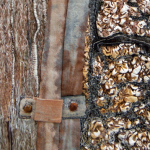 You should ask yourself these questions. What is it that I want to happen to the work I’m producing? Should it be seen in galleries? Or be hung in offices or a domestic setting. Is its sole purpose to make you a living? Are you doing it to express yourself and put a message across? It’s no good doing craft fairs if you’re making fine art installation pieces. However if you are making textile art that you can produce quickly and is not too pricey a craft fair would be an ideal venue. Before you can find an audience you have to know what it is your selling.
You should ask yourself these questions. What is it that I want to happen to the work I’m producing? Should it be seen in galleries? Or be hung in offices or a domestic setting. Is its sole purpose to make you a living? Are you doing it to express yourself and put a message across? It’s no good doing craft fairs if you’re making fine art installation pieces. However if you are making textile art that you can produce quickly and is not too pricey a craft fair would be an ideal venue. Before you can find an audience you have to know what it is your selling.
2, Rachel Biel – Your peers aren’t your audience
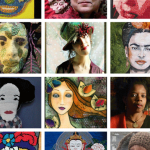 We often “preach to the choir”, relying on our safe, inner circle of peers for affirmation. “We” are not our target audience! Think about who would really love and appreciate what you do, but who is not an artist.
We often “preach to the choir”, relying on our safe, inner circle of peers for affirmation. “We” are not our target audience! Think about who would really love and appreciate what you do, but who is not an artist.
Georgianne Holland of Nestle and Soar often uses birds, trees and nature as her themes in her folk art felt pillows. So, she engages with bird and nature groups and gets featured in their magazines and websites. Weavers and art quilters need to find corporate clients or interior designers who share an interest in their aesthetic.
Fran Seigel and Andy Pastorino of Textile Gems make beautiful cuffs embedding textile remnants under layers of carefully applied acrylic. They target Museum shops. Fran also has a line of cards made of photos of her vintage textiles. She sends samples to boutiques and gift shops that might be interested and once you see them, it’s hard not to want more!
Marketing can become a full time job, so instead of beating the pavement, think of offering commissions to someone who can represent your work. Most receive between 15-30% commission and if they know your audience, it will save you the trouble of finding it and you can focus on your work and be happy.
Top tip: Think outside the box! Look beyond your friends and family. Use the experts and engage in joint marketing efforts with those who have similar audiences.
- Read our interview with Rachel Biel
- For more information about Rachel and TAFA visit www.tafalist.com. If you’re struggling with promoting your work joining TAFA may well be a good idea; Rachel and her team offer great support and guidance for artists looking to reach a wider audience.
3, Susan Lenz – Your audience might not exist…yet
 My advice to an artist seeking an ideal audience is to pull off the blinders of assumption! Don’t assume that an audience already exists. Don’t assume that it exists in a particular area of the arts community. An ideal audience is built from friends, family, social media, and unique pockets of people already known but not necessarily part of an established art support group. Think of an ideal audience as the entire world just waiting to be collected. Start collecting and encourage networking … and do this EVERYWHERE in your life and circle of friends.
My advice to an artist seeking an ideal audience is to pull off the blinders of assumption! Don’t assume that an audience already exists. Don’t assume that it exists in a particular area of the arts community. An ideal audience is built from friends, family, social media, and unique pockets of people already known but not necessarily part of an established art support group. Think of an ideal audience as the entire world just waiting to be collected. Start collecting and encourage networking … and do this EVERYWHERE in your life and circle of friends.
Find alternative venues – Don’t be afraid to show work in alternative locations like coffee shops, church functions, libraries, and the offices of friends or professionals already known from other areas of life. Don’t be afraid to enter juried shows that don’t list “fiber” separately. Think of “fiber art” simply as ART. Offer presentations to groups outside the fiber arts community.
Make a personal connection – Remember that YOU are as important as your work when establishing a supportive group, an ideal audience. It is said a little piece of the artist is stitched into every work of art. Remember to talk about that piece of yourself. It is your connection to your personal, ideal audience. An ideal audience wants the artist to succeed, not just the artwork!
4, Nigel Cheney – Who cares?
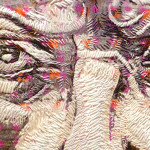 We all know that every year there are hundreds (if not thousands) of new textile graduates. The vast majority of these are incredibly talented and desperate for a future career that appreciates their talent. Finding an audience, people ‘who care’ what we do can seem like a search for a mythical beast. In NCAD, Dublin we do our best to ensure that the Textile Art and Artefact pathway prepares graduates for life after college. Our key strategy to achieve this is by making the contextualisation of their practice a central and assessed part of their modules. This is no small undertaking on the part of the students.
We all know that every year there are hundreds (if not thousands) of new textile graduates. The vast majority of these are incredibly talented and desperate for a future career that appreciates their talent. Finding an audience, people ‘who care’ what we do can seem like a search for a mythical beast. In NCAD, Dublin we do our best to ensure that the Textile Art and Artefact pathway prepares graduates for life after college. Our key strategy to achieve this is by making the contextualisation of their practice a central and assessed part of their modules. This is no small undertaking on the part of the students.
The web can be exhausting, through so many social media, websites and blogs we are bombarded with images of amazing and intriguing work. We use the mechanism of writing a formal, structured report to help students articulate this. The process is developed over 3 years to begin with just identifying ‘ cool stuff’, and whittling down to process, aesthetic, material, outcome and output. Having established what is out there that has relevance it becomes easier to investigate how those artists/designers have managed their careers.
We start from early on in the course to encourage students to locate their practice, to organise events and take on board real life projects. Think laterally. It’s always a fine line between being inspired and being intimidated. Finding the right venue to show/exhibit/sell work takes a lot of effort.
My only real tip is to do your research, give anything a go, and ALWAYS communicate with your audience customers. The database you establish of these personal contacts is the most valuable resource anyone can cultivate. Do let people know what you are up to, show them teasers of work in progress and letting people know in plenty of time when these events take place is all easy enough through the Internet.
Whatever you do I wish you the best of luck. It isn’t easy but there are people out there who LOVE what we do!
- See Nigel Cheney’s book, Textile Surface Manipulation on Amazon UK
- See Nigel Cheney’s book Textile Surface Manipulation on Amazon USA
Stay informed, keep connected
5, Leisa Rich – Use the tools
 For artists choosing one genre of work, my top tips would be to join every related organization, read and subscribe to every related blog, newsletter, magazine, etc. that they can find that specializes in their area of expertise.
For artists choosing one genre of work, my top tips would be to join every related organization, read and subscribe to every related blog, newsletter, magazine, etc. that they can find that specializes in their area of expertise.
For example, an artist specializing in quilts in the U.S. would surely join SAQA, the International Quilt Association and the American Quilters Society, subscribe to Quilting Arts and In Stitches magazines, go to the International Quilt Festival, stay in touch with The Dairy Barn and apply to their Quilt National exhibition, and lots more.
In addition to that, artists should join organizations, blogs, newsletters, etc. RELATED to that area ie join Surface Design Association, subscribe to Fiber Art Now and American Craft, join TAFA, Crafthaus.ning, etc. There are many orgs, mags, blogs, etc. specific to local, national and international to also tap into.
Join a local group that meets and specializes in what you love and attend art shows focussing on your genre. For artists such as myself, the choices are much broader and more demanding! As I work with such a huge variety of materials and techniques, and often more conceptually, I also join groups such as Sculpture.org, read their magazine and other art magazines, attend all kinds of art exhibitions, read a huge variety of art blogs, subscribe to a wealth of publications, the list goes on and on and on!
6, Annette Morgan – Be pro-active
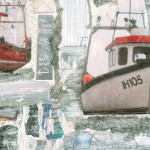 You need to have a clear style of work – and it shouldn’t be a derivative of someone else’s, in other words be original and true to yourself!
You need to have a clear style of work – and it shouldn’t be a derivative of someone else’s, in other words be original and true to yourself!
Collate a body of work and be proactive – get a website, write a blog, approach galleries, both locally and nationally, enter shows, exhibitions and competitions – even if you don’t win, your work will be out there and as people get to see your name repeatedly it will start to stick in people’s minds!
- See Annette Morgan’s book Creative Fabric Techniques on Amazon UK
- See Annette Morgan’s book Creative Fabric Techniques on Amazon USA
7, Jan Beaney and Jean Littlejohn – Team up with like-minded artists
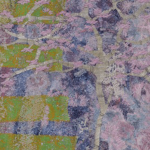 The best advice we can give is to join or create a like-minded group of people who will exhibit and promote together. This reduces any costs and creates an initial bigger audience. The group can seek to exhibit in local libraries, church halls, empty shops, cafes, company foyers and local art shows. They can use local newspapers and posters and the members own social network system to advertise their activities.
The best advice we can give is to join or create a like-minded group of people who will exhibit and promote together. This reduces any costs and creates an initial bigger audience. The group can seek to exhibit in local libraries, church halls, empty shops, cafes, company foyers and local art shows. They can use local newspapers and posters and the members own social network system to advertise their activities.
Books by Jan Beaney and Jean Littlejohn include:
- A Complete Guide to Creative Embroidery
- Stitch Magic: Ideas and Interpretation
- StitchScapes
- Stitch Rhythms and Patterns
- Embellish and Enrich
- For a full list of books by Jan and Jean click here
Be open-minded
8, Anne Kelly – Be open to new opportunities
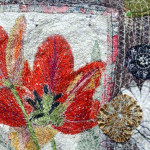 Be flexible, don’t ‘rule out’, without some consideration and investigation, any opportunities that may arise. Make time to research open exhibition and ‘call-outs’ for work. You never know where this could lead you! For example, a few years ago I entered three pieces of work into a local open art exhibition, and won! The work sold and I was featured in the local press, raising awareness of my profile. I almost hadn’t entered, thinking I was too busy with other projects.
Be flexible, don’t ‘rule out’, without some consideration and investigation, any opportunities that may arise. Make time to research open exhibition and ‘call-outs’ for work. You never know where this could lead you! For example, a few years ago I entered three pieces of work into a local open art exhibition, and won! The work sold and I was featured in the local press, raising awareness of my profile. I almost hadn’t entered, thinking I was too busy with other projects.
- Read our article featuring the work of Anne Kelly
- Read Anne Kelly’s article for TextileArtist.org about hanging textile art
- Visit AnneKellyTextiles.com
- See Connected Cloth by Anne Kelly and Cas Holmes on Amazon UK
- See Connected Cloth by Anne Kelly and Cas Holmes on Amazon USA
9, Cas Holmes – Stay open to the unexpected
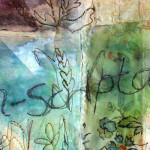 I am not sure if I have an ‘ideal audience ‘. Free email programmes make it easy to create separate lists and you can target your mailout to specific audiences (Local, textile enthusiasts etc). But I sometimes like to think I cast a wider net or prefer to. See who responds and learn to accept you might catch a mix of what you may expect and be open to the unexpected. I have a strong community arts training and see the potential in all ‘audiences’ to interact with art and for me as an artist to learn from that. If your ideal audience is more about the commercial side it may mean your work accommodating more commercial or popular tastes in order to generate sales. 30 years of practice and still a hard balance. I selfishly still want to make the work I want to make.
I am not sure if I have an ‘ideal audience ‘. Free email programmes make it easy to create separate lists and you can target your mailout to specific audiences (Local, textile enthusiasts etc). But I sometimes like to think I cast a wider net or prefer to. See who responds and learn to accept you might catch a mix of what you may expect and be open to the unexpected. I have a strong community arts training and see the potential in all ‘audiences’ to interact with art and for me as an artist to learn from that. If your ideal audience is more about the commercial side it may mean your work accommodating more commercial or popular tastes in order to generate sales. 30 years of practice and still a hard balance. I selfishly still want to make the work I want to make.
- Read our article featuring the work of Cas Holmes
- Read Cas’s article for TextileArtist.org on finding inspiration
- Visit CasHolmes.TextileArts.net
- See The Found Object in Textile Art, a book by Cas Holmes, on Amazon UK
- See The Found Object in Textile Art, a book by Cas Holmes, on Amazon USA
- See Connected Cloth by Anne Kelly and Cas Holmes on Amazon UK
- See Connected Cloth by Anne Kelly and Cas Holmes on Amazon USA
Research
10, Karen Nicol – Don’t be afraid of networking
 I think what I would do is do some research by going to a few art fairs, Art London, London Art Fair, 20/21, Affordable Art, Lapada (I only know the London ones, sorry but they are bound to be online); these are vast halls full of all the galleries with stands showing their wares, take notes on the ones you like or ones that sell work which is along the same lines as yours. If you can get chatting to the people behind the desks when they aren’t busy and maybe leave a postcard of your work and try to make an appointment to show more…if they are busy take a card and photo the work on the stand so that you know what they do and send them a small package showing your work saying you are looking for an outlet then ring them and again ask if you can come and see them and have just 5 minutes of their time to show them your work…..
I think what I would do is do some research by going to a few art fairs, Art London, London Art Fair, 20/21, Affordable Art, Lapada (I only know the London ones, sorry but they are bound to be online); these are vast halls full of all the galleries with stands showing their wares, take notes on the ones you like or ones that sell work which is along the same lines as yours. If you can get chatting to the people behind the desks when they aren’t busy and maybe leave a postcard of your work and try to make an appointment to show more…if they are busy take a card and photo the work on the stand so that you know what they do and send them a small package showing your work saying you are looking for an outlet then ring them and again ask if you can come and see them and have just 5 minutes of their time to show them your work…..
- See Karen Nicol’s book Embellished: New Vintage on Amazon UK
- See Karen Nicol’s book Embellished: New Vintage on Amazon USA
11, Carol Naylor – Be consistent and seek out your audience
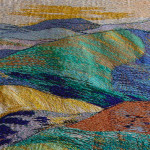 So you’ve recently graduated, completed a textiles course or simply arrived at the stage where you feel your work is ready to be shown to a wider audience.
So you’ve recently graduated, completed a textiles course or simply arrived at the stage where you feel your work is ready to be shown to a wider audience.
Step back, look at what you make or want to make and be both objective and realistic.
Who is your target audience? How can you fund work if it is unlikely to fit more conventional venues? If you want to sell work you MUST have consistent pricing methods even though galleries usually take 50% or more of the retail price. Don’t put something on your website for £200 but ask a gallery to sell at it £400 or more. If they find you undercutting them substantially it will be the end of the affair!
It is worth looking at the websites of artists whose work you may feel is compatible with your own. This will give you some idea as to where they show their work and could help you make a start in compiling possible outlets.
There are also lots of websites that list opportunities. You may need to join a group, society or other organisation in order to meet like minded individuals. Remember you can offset membership fees against tax.
Useful sites for finding an audience include:
- http://www.axisweb.org
- http://www.artquest.org.uk
- http://www.designfactory.org.uk
- http://www.CraftsCouncil.org.uk
Finally, you will get rejections but then someone will say yes!
- Read our interview with Carol Naylor
- Read Carol’s article for TextileArtist.org about submitting work to galleries
- Visit CarolNaylor.co.uk
12, Jo Smith – Spend time researching appropriate galleries
 I have found that not all galleries are interested in textiles, its somehow seen as a poor relation when it comes to fine art and so I tend to seek out places that I know have previously held exhibitions that included textiles, this may also mean that they have regular visitors that enjoy textile art. Events such as Open Studios and Open Exhibitions are also a way to get your work seen, as I feel that before you can target your ideal audience you first must get your work out there as much as possible so that it is seen by an audience at all, what I like is to get a response from the viewer and for them to connect with my work in some way, I have come to discover that that’s something that can happen absolutely anywhere.
I have found that not all galleries are interested in textiles, its somehow seen as a poor relation when it comes to fine art and so I tend to seek out places that I know have previously held exhibitions that included textiles, this may also mean that they have regular visitors that enjoy textile art. Events such as Open Studios and Open Exhibitions are also a way to get your work seen, as I feel that before you can target your ideal audience you first must get your work out there as much as possible so that it is seen by an audience at all, what I like is to get a response from the viewer and for them to connect with my work in some way, I have come to discover that that’s something that can happen absolutely anywhere.
Let your audience find you
13, Erin Endicott – Focus on the work…let the opportunities flow
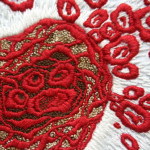 As an artist whose work is not only difficult to categorize ( is it “fine art”, is it “craft”??), but also provocative in its imagery, I have found it best to let my audience find me. Earlier in my career I put a lot of time into promoting my work via social media (and others in turn spread the word – or images as it may be – like wildfire) and carefully selecting exhibition venues where my work would be presented tastefully and with respect. As notice was taken of my work I began to be approached by galleries/curators who were seeking out work like mine. The most fruitful doors have opened not by my seeking them out but by me focusing on my work and allowing opportunities to flow to me.
As an artist whose work is not only difficult to categorize ( is it “fine art”, is it “craft”??), but also provocative in its imagery, I have found it best to let my audience find me. Earlier in my career I put a lot of time into promoting my work via social media (and others in turn spread the word – or images as it may be – like wildfire) and carefully selecting exhibition venues where my work would be presented tastefully and with respect. As notice was taken of my work I began to be approached by galleries/curators who were seeking out work like mine. The most fruitful doors have opened not by my seeking them out but by me focusing on my work and allowing opportunities to flow to me.
14, Andrea Graham – Make it easy for an audience to find you
 It is a matter of making it easy for your ideal audience to find YOU. Create a web presence and find a venue that is suited for your work that will market you, whether it be a museum shop, gallery, or local craft event, wherever you have a sense your work fits in.
It is a matter of making it easy for your ideal audience to find YOU. Create a web presence and find a venue that is suited for your work that will market you, whether it be a museum shop, gallery, or local craft event, wherever you have a sense your work fits in.
Make work for yourself
15, Abigail Brown – Find others like you
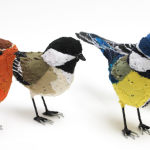 I make work for myself, so my audience is similar minded. It makes it very easy to locate them as they’re in all the places I would be: the same magazines, shops, blogs etc.
I make work for myself, so my audience is similar minded. It makes it very easy to locate them as they’re in all the places I would be: the same magazines, shops, blogs etc.
16, Leigh Bowser – Connect with like-minded people
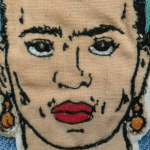 I think almost all artists create work they would own themselves, so they already know their target audience – people like themselves. Seeking them out isn’t as difficult as you’d think, especially with so much online social media. Most of my audience are based across seas, and without an online presence I wouldn’t be able to reach them. Being an active blogger, tweeter, and Facebooker are all important. Regularly updating all of these networks, interlinking them with each other, and following fellow artists and like minded fans are the best way of building up relationships. Keeping on top of search engine optimisation (knowing the right keywords for your website etc.) also helps your target audience find you!
I think almost all artists create work they would own themselves, so they already know their target audience – people like themselves. Seeking them out isn’t as difficult as you’d think, especially with so much online social media. Most of my audience are based across seas, and without an online presence I wouldn’t be able to reach them. Being an active blogger, tweeter, and Facebooker are all important. Regularly updating all of these networks, interlinking them with each other, and following fellow artists and like minded fans are the best way of building up relationships. Keeping on top of search engine optimisation (knowing the right keywords for your website etc.) also helps your target audience find you!
- Read our interview with Leigh Bowser
- Visit LeighLovesYou.com
- Learn about Leigh Bowser’s Blood Bag Project
17, Debbie Lyddon – Create for yourself but play to your audience too
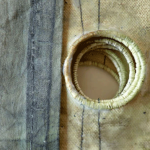 To be able to identify your ideal audience you need to fully understand what you are trying to achieve with your work. As a textile artist your work is likely to straddle both the fine art and the craft sectors – it may be concept led, be driven by process and technique or be a bit of both. You need to decide what it is and be able to describe it in the right sort of language.
To be able to identify your ideal audience you need to fully understand what you are trying to achieve with your work. As a textile artist your work is likely to straddle both the fine art and the craft sectors – it may be concept led, be driven by process and technique or be a bit of both. You need to decide what it is and be able to describe it in the right sort of language.
I have realised that I need to make two types of work – 1.experimental, process and concept driven work that drives my practice forward and 2. smaller, domestic pieces that are inspired by the exploratory work but that are made for sale. I have found that my audience are interested in both the (sometimes challenging) concepts and research that back up my work and the techniques and processes that I use. However they don’t want large, abstract cloth works in their homes! Smaller, derivative works that are described in a simple, jargon-free way provide a small taste of what I do and fit the purse and the wall.
Concentrate on the work
18, Barbara Shapiro – Don’t be limited by definitions
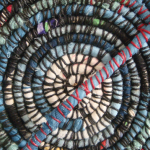 Seeking exposure is different than seeking sales. My focus has been to be able to continue the exploration of textiles as an art medium, not on earning a living. My audience seems to have grown through lecturing, teaching, writing, serving on museum and textile organization boards, as well as through group and invitational exhibits. I recommend continuing to refine your skills so that you have the confidence to express clearly what you have to say. Technical confidence is very appealing. Try not to be limited by definitions. Enter all kinds of exhibits and remember we are artists who work in textiles. This may define our medium, but not necessarily our audience.
Seeking exposure is different than seeking sales. My focus has been to be able to continue the exploration of textiles as an art medium, not on earning a living. My audience seems to have grown through lecturing, teaching, writing, serving on museum and textile organization boards, as well as through group and invitational exhibits. I recommend continuing to refine your skills so that you have the confidence to express clearly what you have to say. Technical confidence is very appealing. Try not to be limited by definitions. Enter all kinds of exhibits and remember we are artists who work in textiles. This may define our medium, but not necessarily our audience.
Be persistent and determined
19, Barbara Cotterell – Go with your instinct
 Line up the possibilities , research well and go with your instinct. If the door does not open this is helpful guidance. Shake the dust off your feet and try the next thing on the list. Don’t waste time procrastinating.
Line up the possibilities , research well and go with your instinct. If the door does not open this is helpful guidance. Shake the dust off your feet and try the next thing on the list. Don’t waste time procrastinating.
20, Sue Stone – Don’t give up
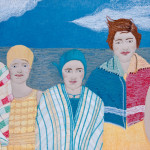 Whether the artist’s aim is to exhibit their work and reach a wider audience or to sell their work my advice would be the same. Be determined, aim high, apply for everything you can afford to and don’t give up if you don’t succeed at the first go. Use every tool available for promotion ie website, blog and social networking. Do lots of research and don’t be afraid to approach anyone who can help you get your work out there.
Whether the artist’s aim is to exhibit their work and reach a wider audience or to sell their work my advice would be the same. Be determined, aim high, apply for everything you can afford to and don’t give up if you don’t succeed at the first go. Use every tool available for promotion ie website, blog and social networking. Do lots of research and don’t be afraid to approach anyone who can help you get your work out there.
Feed the soul as well as the wallet
21, Pippa Andrews – Seek rewards other than financial
 This really is a difficult question! As far as selling is concerned, my work is not very commercial and while I love it when people buy what I make, I can’t rely on it as a source of income. I think, for selling, my ideal audience would be people with business premises who could display my work in their foyers and on large office walls, but I have yet to find a way of reaching them! So I make without a particular audience in mind. However, I do try to exhibit. There are rewards other than financial and it feels good show my work, to get feedback and to hopefully spark off someone else’s creativity. For this type of reward, trying to get into an exhibition which attracts a lot of people who are interested in textile art is my top tip.
This really is a difficult question! As far as selling is concerned, my work is not very commercial and while I love it when people buy what I make, I can’t rely on it as a source of income. I think, for selling, my ideal audience would be people with business premises who could display my work in their foyers and on large office walls, but I have yet to find a way of reaching them! So I make without a particular audience in mind. However, I do try to exhibit. There are rewards other than financial and it feels good show my work, to get feedback and to hopefully spark off someone else’s creativity. For this type of reward, trying to get into an exhibition which attracts a lot of people who are interested in textile art is my top tip.
Final thoughts
22, From Tilleke Schwarz
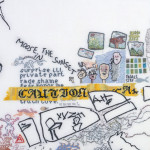 Everyone wants to know how to find the ideal audience (buyers?) for your work. I can understand the need for this information, but sorry to say, there is no simple answer to this question.
Everyone wants to know how to find the ideal audience (buyers?) for your work. I can understand the need for this information, but sorry to say, there is no simple answer to this question.
It all depends on the kind of work you make and what you aim at (being world famous, selling a lot etc.).
- Always spend a lot of time and effort on PR. It is not difficult, just a lot of work.
- Take everybody interested seriously as you may never know what it will lead to.
- Make an effort to have perfect images that represent your work accurately. The picture should be honest so don’t use too much Photoshop.
- Inform major magazines of your work and shows and everybody else who seems interested.
- Read (international) magazines and engage in competitions. It is especially helpful when you win a prize as this generates a lot of free publicity.
- Take part in international art competitions and not only in the textile/fibre world but for any kind of art. For instance apply for the famous summer exhibition of the Royal Academy in London.
- Make use of the media!
Good luck!
- Read our interview with Tilleke Schwarz
- Read Tilleke’s article for TextileArtist.org about selecting and using threads in your work
- Visit TillekeSchwarz.com
23, And Carol Shinn
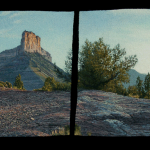 There is much advice around stating that you must first follow your bliss and then an audience will follow. But there is more to it than that. Art is communication, so an artist must try to make their work at least a little bit understandable to an audience they hope to reach.
There is much advice around stating that you must first follow your bliss and then an audience will follow. But there is more to it than that. Art is communication, so an artist must try to make their work at least a little bit understandable to an audience they hope to reach.
The kind of work produced for a university audience or program will need to be more esoteric or conceptual than work designed for a more general audience. If you hope to get your work in art centers, then you might be able to produce installations, but it might also mean writing grants for one-person exhibits. You might get these larger pieces purchased for public spaces, but you will need to compete with grant writing or applications. This are less frequently available than they were in the 1980’s and 1990s.
Installations will probably not get you into galleries that must make money to exist. Galleries look for things that they can sell to collectors and other people they can entice to purchase a piece. Collectors might search for work online or they might walk into a gallery in person. They will be looking for smaller pieces that can fit with other things they have purchased. Galleries are also less common than they used to be.
That may mean you need to have a really good website to sell from. This means your work has to look good in the photograph you put up. Not every kind of work is shown well in a photograph, so that can make it difficult. Some people sell things by opening up their studios on a limited basis, or selling through art fairs. Your audience then may buy bigger things or things that are difficult to photograph, but likely most people seeing your work will be looking for smaller affordable pieces.
My advice is to experiment with different ideas and venues until you find a comfort zone that balances all these tricky issues with the kind of thing you want to communicate. Most of all be patient. Know that the skills and ability to make good work takes time. It make take a while to work it all out.
If you’ve found these tips useful let us know by leaving a comment below or share your top tip for finding an audience as a textile artist.

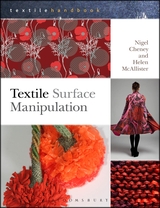
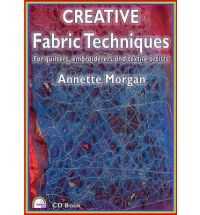
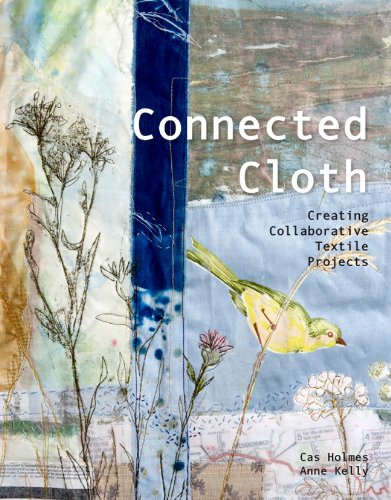

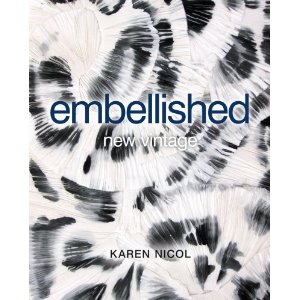















WOW! I gained a lot of excellent tips and got a lot of sure-fire advice here. Thanks so much to all of the experts for weighing in on these important suggestions. Even serious artists like myself can glean a lot of good things from this kind of article. Thanks, Textileartist for this valuable pulling together of insight and expertise!
Hi Leisa – thanks so much for the comment. Glad you found it useful and thanks so much for your own great advice!
This is great! And, you are right- some of the advice is contradictory, but many also confirm each other. The beauty of having many voices chime in on a topic like this is so valuable as it documents the process each of us has experienced and it really is a unique journey for each person. I’ll definitely share this around and hope that you will do other combined posts like this. I enjoy receiving your posts by email and encourage others to sign up and share broadly!
Thanks Rachel – your advice is very pertinent and something I think many artists can benefit from. Looking for an audience outside your peers makes perfect sense.
Many commonsense ideas here – that all artists may consider. Having a good relationship with the internet and being easily contactable is the key, I feel. I sell my work to a wide audience, epeat customers and internationally. I could not do this without the internet. I am happy to sell my work at a price that I feel is affordable, knowing the work will be appreciated. That is why I prefer to stay a bit of an outsider and do not show in galleries very often, I’ve diversified also in recent years – not only working in stitch or with textiles, but also painting and so on… as often a customer may find me via one area of my work and get interested in another aspect too.
I think being multi-faceted and diversifying is something we can all benefit from. I’ve heard many artists say that doing the promotion takes them away from the act of making, which I understand must be frustrating. However, I think with practise and being selective (doing the promotion you choose to do really well and not trying to be on every single available platform) it can become easier and more second nature. Anyway I’ve gone off your topic somewhat! Thanks for the comment.
Just the article I have been looking for, also the interviews are stimulating. I sell well at textile group exhibitions but need to move onto the next step.
Hi Glen – so pleased you found it useful and that you like the interviews. Just out of interest, what do you see as the next step on from group exhibitions?
I wholeheartedly agree with Leisa Rich. The information and varied opinions expressed in this article are excellent and thought-provoking. Thank you, Textileartist for making this possible.
Susan
And thank you for contributing to the article Susan. We’re really proud of the group we managed to gather to give their little nuggets of advice. I love the way that everyone has something slightly different to say and that it offers a broad range of opinions. It shows that different things work for different artists – it’s just about pinpointing what that might be for the individual.
Thank you Barbara Shapiro for your statement: Don’t be limited by definitions.
I am a true believer of ten thousand hours of practice to make a difference.
Hi Lily – thanks for your comment. I really respect Barbara’s work ethic and it’s something we can all learn from. It can be very easy to look for quick-fixes in this technological age, but nothing pays off like hard work. Barbara’s stunning work is a testament to this.
Very useful article, thanks. Personally I try to make good use of the internet and social media, particularly Twitter. This has been especially important since gallery exhibition opportunities seem to have lessened recently due to the recession so word of mouth and knowing people has increased in importance for me. There used to be lots of exhibitions I felt were worth applying for in places like AXIS and [an] but now there is definitely less and the opportunities that are available often charge submission fees.
found your blog ‘Finding an audience for your art: Top tips’ extremely useful with plenty of food for thought and action. I enjoyed the interviews that cut across a large spectrum of artists and continents especially as I have had to pleasure to have met some of the well known and I am still mourning the premature death of a wonderful lady, embroiderer, teacher, author Valerie Campbell-Harding who inspired and encouraged me way back in the 90s.
Just the article I needed! I recently opened my own business at http://www.quiltzone10.com and the prospects of moving beyond my peers, friends and family, seemed onerous. However, having read all the tips, it would appear that I’m in a quasi-normal state for the state I’m in! Thanks for this article.
CEO, Quilt Zone 10
It was very helpful putting these comments together like this. I was especially inspired by those who are creating and making and NOT making a living at it and doing it anyway. I am currently writing a mission statement and this was a tremendous help!
Very, very helpful, especially the comments that echoed the quiet little voice in the back of my mind saying, “Try this”. Thank you so much to all.
Great, very helpful article
Fantastic article, full of really helpful advice. Thank you for getting all these artists to pass on their tips.
Just the article I have been looking for, also the interviews are stimulating. I sell well at textile group exhibitions but need to move onto the next step.
Excellent article, even for an aspiring painter. The biggest struggle for me is to create based on my artistic needs or based on what customers like.
LOVE all the information each artist provided. It was most helpful, professional and well written.
Thank you so very much for gathering all this valuable information.
Very useful article. Even though I am not a textile artist, but a fine artist (painting) it is very helpful. And subcribing to your newsletter has helped me one step further in expanding knowledge about my audience ;).